Description
- Fast Solar Charging: With up to 800W of solar input, DELTA Max is a solar powered generator that charges fast. With a single 220W panel, you can charge in 11.5 hours. Ideal for power outages.
- Large Capacity: 2016Wh of energy stored means you can use it as an outdoor generator, or indoors for backup power. Keep appliances going for hours on end.
- Clean, Green & Quiet: Replace your traditional gas generator with a solar generator. No fumes, totally portable, no noise and renewable charging. Compatible with both EcoFlow solar panels and select third-party models.
- Power Pretty Much Anything: With X-Boost technology, DELTA Max can power almost all your home appliances and devices up to 3400W. Great for power outages, camping or RV trips.
- Lightweight & Waterproof: 220W double-sided solar panel is foldable and compact, weighing only 21 lb, making it easy to carry or store. With a thin tempered glass design, it’s 5 times more durable than similar solar panels. Its IP68 rating makes it both water-resistant and dustproof.
- Control From Afar: With the EcoFlow app, you can monitor your portable power station, control it & more. All the while the internal BMS keeps you safe. To ensure prompt delivery, please note that the DELTA Max(2000) Solar Generator and 220W Solar Panel will be shipped separately. If you receive one item before the other, kindly await the arrival of the remaining item.
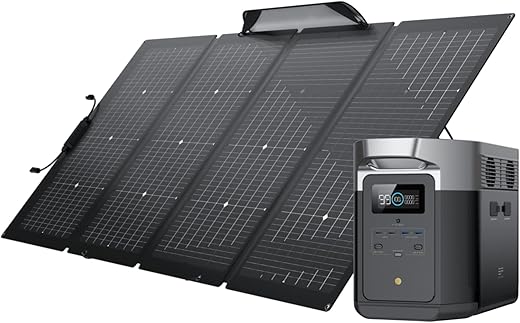



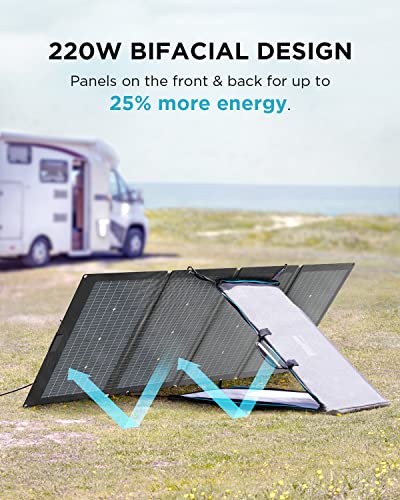

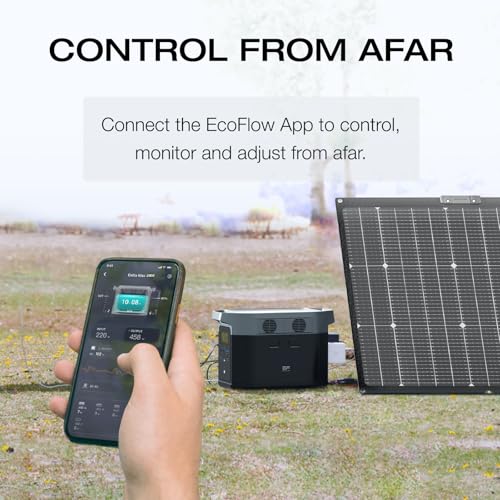
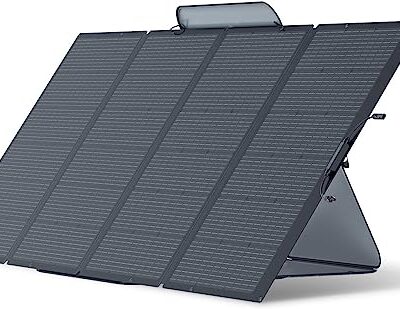
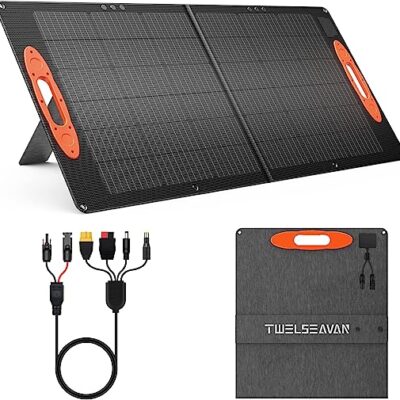
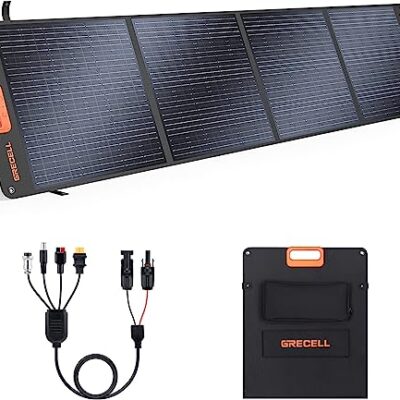
College Reader –
So I used to have a 75 ft extension cord running out to my tool shed that plugged into a 20 amp generator inlet. I didn’t want to deal with trenching and running a line so I figured I would experiment going off grid with this product and some solar panels. I will list the good and bad below with each issue I ran into
Charging the generator: I used 4×200 watt solar panels on the roof and ran them to the machine. One the best day so far I have gotten about 475 watts input on the solar panels and have two facing east and two facing west since I am looking for the longest input not the highest. It charges just fine without any issue. At dusk I can hear a relay clicking which I looked up and other users have reported it is the solar generator recognizing some minor input by the solar panels but not enough to click over the charging aspect. I hope there is no long term issues with the relay
App: The app is amazing and I love it. The garage gets very mild wifi but the generator is able to pick up on it. Set up is a breeze and I can control the outlets, run time, charge capacity etc from the app. It is very convenient.
Power: The power is absolutely amazing. I have my garage hooked up with 6 Shop LED lights drawing about 300 watts and a fan on a seperate 15 amp circuit and a sump pump that is crucial for the drainage in the backyard + and any power tool you can imagine on a dedicated 20 amp circuit. The 20 amp I have a true HD 20 amp plug running into the inlet. I have turned on the lights, sump pump and air compressor all at once and this had no issue powering everything with zero start up lag. I turned the sump pump off and powered up the shop vac and measured the watts and was close to 1800 with the vac and compressor on. I am absolutely impressed with the power this thing can deliver and was super worried about it running these things however it shows no issue. I have faith it will power the table saw and miter saw without issue as both those machines draw a lower wattage and amps than what I experimented with.
Run Time and Measurement issues: This is my biggest concern with this machine is I don’t feel the battery capacity is a true 2kwh design. I have a “kill a watt” measurement tool and it is measuring my sump pump at 680 watts however this is measuring the same pump at almost 800 watts. That is a huge discrepancy and it seems like there is a markup of watts in anything it is running. For example my bug zapper on the kill a watt measures at approximately 60 watts but on the generator it is pulling 78 watts. It is almost like anything drawing current is marked up by almost 15-20%.
Another major issue I have is the machines draw on itself while just sitting there. My shed has a constant draw of around 5 watts (measured with the kill a watt machine) when everything is off. This should mean that with nothing running I should still get roughly 16 days off the machine with nothing running. That isn’t the case as it will run itself down in about 2.5 days without anything powered on. That means the generator itself is drawing a considerable amount of power just to keep itself on whether that is to keep it connected to wifi or keep the fan going etc. Not sure why but that just feels unnaceptable to me. I will go to bed and it will be at 100% and I will wake up and it will be at roughly 82%. That makes it really tough to be reliable in the winter when I am not getting a huge solar input. I am worried that it won’t be able to keep up with the draw let alone power the sump pump and anything else needed during that time frame.
I could get another battery to supplement this but you are limited to 800 watt solar input and to charge almost 4kwh isn’t going to happen on the best day in the winter where I live. That is a huge cautionary tale for anyone looking at this for off grid.
Edit #2: So I am halfway through winter and found two things out. I can extend the standby by turning off the power to the outlets and just keeping power to the USB chargers. This gives me roughly 10 days in standby mode and I can still log onto the unit and see what the power is and it still connects to wifi. Only problem is it does not charge below 40 degrees Fahrenheit. So for the most part it will be sunny and will not charge if it is under a certain temperature.
Nagendra Saini –
Le facteur le plus important a vérifier …est la chimie de la batterie ce qui détermine le nombre de charge avant le début de la dégradation du pack et la garantie que le fabricant donne sur l’unité. La connectivité de ce module est impressionnante, le logiciel impeccable sur cellulaire (j’aimerais une version PC) les panneaux solaire de 200 watts mon donner a froid 240 watts à chaud 140 à 175watts si l’ont considère que mon frigo ,système informatique et 1 à 2 lumières consomme au max 400Watts mon autonomie est environ de 8 hrs sans batterie supplémentaire . 200 watts de panneau solaire ne sont pas suffisant pour aller au-delà de 8 hrs 400 watts est de beaucoup préférable. Petit bijou a tout faire …. Louis
Nomad347 –
I took advantage of the sell this past July 16th. I got this unit with solar panels for myself and my kids in Wisconsin and Florida. We should be ready for any power outages situation. I live in Texas and recently experienced being out of power for 9 days before getting my new power source. I had a gas generator that I hated due to the noise in created and the dangerous carbon monoxide. I look forward to using this new power source. I bought 2 additional batteries as well to run my a house.
Sarah Poon –
This was a total waste of money. 2 years after purchase, it has no ability to recharge. Tried connecting via AC and DC, and it won’t charge.
I have never owned a battery that couldn’t recharge itself. How could that function fail?!!
Asked customer support and they said I need to ship it back, but without any estimate for the fix. I even bought the 400 watt solar panels for it. I used it only a handful of times for camping and home use during power outages. I will never buy an Ecoflow product again!
After a year, it had around half of the expected capacity. Wouldn’t charge my portable fridge for very long (about 3 days). Then a couple months ago, it stopped being able to take any input for charging. No ability to reset, no hard factory reset, it just died. Now I have a 40 pound lump of lithium ion that’s just sitting around taking up space. Who knows – software? fuse? hardware?? Either way, to fix is going to be a pain in the a$$ and may cost a fortune because Ecoflow support can’t give me an estimate.
Louis –
We camp in a travel trailer. Sometimes in campgrounds, the power goes out, even on electrical sites. This power station will easily run the whole trailer (not the air conditioner too) for hours. We have used this when boondocking on our travels for this very purpose – to run the whole trailer. Good solar panels will charge it back up, or connecting it to the cigarette lighter socket when back on the road, or its AC plug will get it charged up again. Its weight isn’t too bad for the two of us women in our 50’s. Wouldn’t want it much heavier unless of course it came on wheels like larger versions of this have. Would highly recommend having this with you for your travels…or for home use too, during a power outage.
Bruce Murdoch –
This product has lots of whistles and bells such as measuring input, output and SOC. Lots of ways to connect. I haven’t had it long enough to monitor the effectiveness of the solar panels but they do seem to need full sunlight, otherwise it is measuring no production at all in the shade.
Michael L. Williams –
Love the way the controls and features of this power station are so comprehensive, with the modular aspect even, with the ability to add extra batteries and increase the watt-hours. The remote control App is awesome! Love the way you cannot only monitor the system, but control it from the app as well, from anywhere. Very versatile. Also love the feature of being able to use solar to charge the power station while at the same time running appliances with it. The only drawback is the weight of these things, which is to be expected with something that has so much power. This one is almost fifty pounds; I use a hand truck to move it around and save my back from hefting it.
Note Re: Operating Environment Based On Testing Of My Unit – Delta Max 2000 2016 KWH:
As rugged as this unit is, such as weather-proof etc., it is not designed to operate quite as well in temps of 100 degrees or more for a long time. It has a fan that turns on automatically and helps to cool the power station, and the unit will definitely charge in 100 degree temps, but the heat will lower the rate of charge. Better charging efficiency is obtained when it’s inside a cooled environment at around 88 degrees max. I noticed the unit charged very well at a good rate when inside & a max temp of around 88 degrees, but when being charged outside on the second day, when the unit is already warm from the previous day, and the temp reading about 91 degrees, the rate of charge was not nearly as good, reaching a maximum charge rate of about 50 watts during a four hour charging period, compared to charging at over 100 watts when inside and cooler. It still charges in the heat, but not nearly as much.
I bought a small condo three years ago and liked the fact that the condo complex is all electric, no gas, nothing to blow up, as we’ve all seen here and there. But as we also know electric is more costly, which is why it’s nice to get such a lot of power from the sun for nothing, after the cost of the power pack and solar equipment.
So when I got my place I noticed the AC worked fine but was not really efficient being 18 years old, and the heating element for heat had burnt out long ago. So last year I had the entire HVAC system replaced with new central air AC and Heat. The AC is fabulous, quieter than the old unit, and more cost efficient as well. When cold weather came around I loved the new central air heating system, but quickly noticed it was very pricey to use. My electric bill jumped up a lot. So I started using an inexpensive oil/radiator type space heater that does a great job of heating my modest 500 sq foot place, and saves me a bunch of money. And now with my new power station and some solar panels the winter heating will cost even less.
This awesome power station is also great for emergencies. The power company here is very good, and if the power is out, they are on top of it and have the power back on in an hour or two. But an hour or two can be a very long time without any AC or Heat. The power station takes care of warming the place up in the cold weather, as well as powers a couple big cooling fans for many hours when it’s hot.
But as good as the power company is, there was a storm last summer where some people had their power out for a couple days instead of a couple hours. A power station like this would come in very handy in a mess like that.
And as far as the solar panels to be used with this power station, I’m sure there are a lot of good ones around, but like many newbies to solar, I found it best to stay away from the panels made for charging a car battery with a max of 25 watts, and having to be sent back for neglect of paying better attention to what is being ordered. My personal choice would be the ECOFLOW panels, that deliver an awesome power punch, as well as having nice features for portability, and they are not paying me to say that. I have one of the 160-watt ECOFLOW panels that way outperforms and 800-watt set of panels that max out at 25 watts. And also adding a second 220 watt solar panel to provide a total of 380 watts.
After using this power station for a couple weeks or so, there was an issue or two that came up. I noticed that I got great power from the 160 watt solar panel, and even more power when I added another 220 watt panel, about 260 watts at peak, which seems pretty good. Then about the third day I was charging from the solar panels I noticed on the Power Station display screen, as well as the read out from my phone, something strange. It showed that the input source was a car battery, when I clearly knew it was from the solar panels, and the amount of power coming in, rather than around 200 watts or so, was only 45-50 watts.
I phoned tech support about this, they asked me if I had the latest firmware update, which I did. Then they said, as a solution, remove the input power source, turn the power off and leave it off for at least an hour. Turn it back on after an hour, which I did and saw the problem was resolved. Tech Support said that if this continued to happen, let them know and they would look at other solutions to the problem. It did happen only once more then was fine. I could be wrong but suspect the problem could be due to not allowing the power station to discharge enough, before charging it back up. At least that what I understand from other sources that mention how to keep a lithium ion battery healthy. So I make sure to let the battery discharge to almost empty before charging it back up.
Another problem happened, which was the ECOFLOW phone app showing that the power station was not on, and disconnected. But I could see clearly that the power station actually was on. Then I looked at the display screen on the power station and noticed the little white wireless icon was not showing. So I turned the unit off for just a minute or so, turned it back on, and could see the little wireless icon showing, at which point the app on my phone was working correctly, showing that the power station was on etc.
Amazon Customer –
Purchasing this on the Black Friday deal was fantastic. for camping, it has proven to be superb. Though, one problem was that it didn’t link to the solar panel that accompanied it in separate packaging. I sent the solar panel back as defective. but I may never really know for sure.
Monica B. –
It lasted 3 nights when using my CPAP machine with some extra power left over for a partial night. It does what I was looking for. Great unit and very happy with it.
Nagendra Saini –
The media could not be loaded.
I purchased ecoflow deltamax. This product is just excellent. It’s well worth the money. It runs almost all daily need appliances. This product is my compnion in my tours,camping and in vedio creation. Highly recommended.